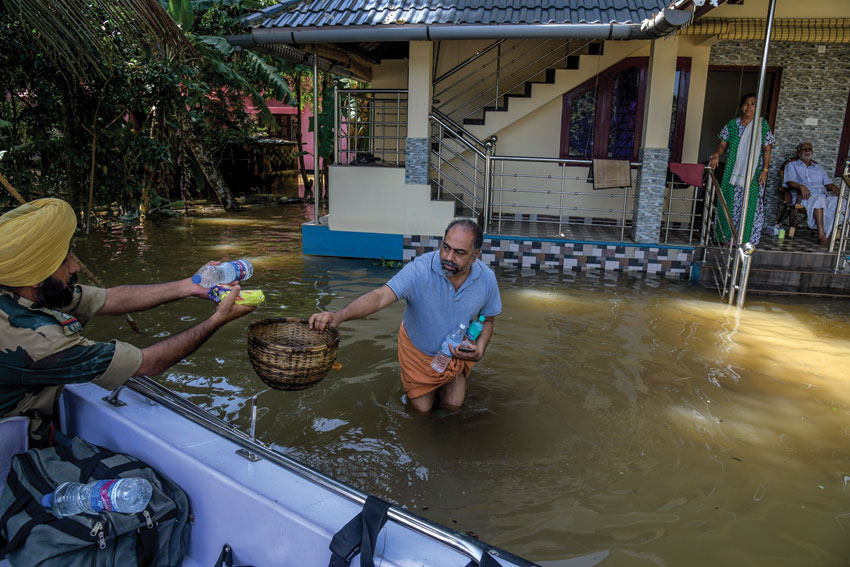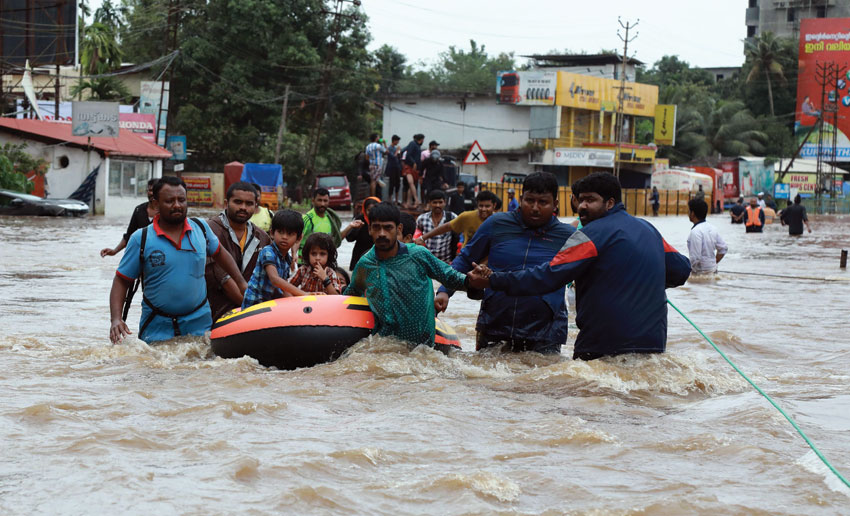‘God’s Own Country’ Drenched: Rains, Aid, and Fake News, Flood Kerala
Indian volunteers and rescue personnel evacuate local residents in a boat in a residential area at Aluva in Ernakulam district, in Kerala, Aug. 17. The death toll from floods that have triggered landslides and sent torrents sweeping through villages in Kerala trebled on Aug. 17 to over 400, authorities said, amid warnings of worse weather to come. (AFP/Getty Images)
This monsoon Kerala, a southwestern coastal state at the tip of the Indian Peninsula, enjoying a long coastline along the Arabian Sea and with the Western Ghats running longitudinally, received two and a half times more rains that resulted in devastating floods, flash floods and landslides that went on to leave over 400 dead, displace thousands of people, completely damage infrastructure and property worth billions of dollars and made large parts of the state inaccessible, writes Priyanka Bhardwaj.
The worst ever experienced by the state since last 100 years the central government declared it a Level 3 Calamity or Calamity of a severe nature and immediately pressed into action all wings of the defense and disaster management personnel for rescue, relief and rehabilitation operations that will go down in disaster management history as an exemplary show of effort, duty and courage.
With as much urgency the first tranche of central assistance of Rs. 6 billion was extended to the state apart from donations from Indian and overseas individuals and charitable organizations adding to the aid-corpus.
But as the rains have started abating, waters receding, those in temporary shelter homes are gearing to make their journeys back home, to an uncertain scenario of debris or whatever is left, it is time for the government is also getting down to the second stage of rehabilitation and reconstruction, and prevention of any such future crisis.
For this it will have to account for its passivity on the warning bells sounded by climate experts who have always predicted and continue to do so in ecologically sensitive areas of the state as the weather gets more extreme due to global warming, the center’s inability to get six states, through which the Western Ghats run across, to stop their irresponsible environmental policies that led to indiscriminate denudation of mountains, deforestation of forests and development activities expanding into “No Go” zones earmarked by the Ministry of Environment and Forest (MoEF), and deliberate overlooking of the 2017 report by Comptroller & Auditor General of India that exposed the absence of any emergency action plan on any of the 42 dams built on 44 rivers, all of which risked mountainous and forest regions as well as riverine and coastal cities, and justify the accusation that this was a “man-made calamity.”
Peculiar as it may sound the state’s airports stand on paddy fields, wetlands and rivers just as in other parts of the country—the Mumbai airport has been raised on Mithi River and the Chennai one on Adya River, thereby flouting every parameter of stability and safety.
Therefore, it is not difficult to believe that the state has incurred a loss of not less than Rs. 200 billion and the decline in the state’s gross domestic product may close to 1%, going by CARE ratings.
Staring on the face are also questions of how far the relief and rehabilitation forces will be successful as historically these operations only aim for providing solutions for the bare minimum in development facilities.
And a careful consideration of prevalent state-policies that are based on public-private partnerships guided by principles of profit making may require major amendments to allow for unimpeded, quick flow of central and public initiated investments that are in consonance with environmental governance.

Amidst the deluge and unprecedented strife, a slugfest of sorts has been ensuing in the political, public and social media spheres as lies on funds to the tune of Rs.7 billion being offered by the UAE government were peddled.
It is widely known that Malayalis/Keralites who form a sizeable expatriate-community are a vital force in the economy of the UAE and the manner with which a figure was put to the false rumor and synchronized social messaging was carried through the news made it to national headlines so much so that an unwitting Indian Ministry of External Affairs announced its policy for refusal to accept aid from a foreign government.
This policy that was framed by the previous UPA government in 2004 on the premise that India has the economic power to withstand calamities is the basis for refusal of aid from Maldives, Qatar and Thailand, though there does not apply to support from overseas individuals and charitable organizations.
Notwithstanding the impact it may have on the psyche of the distraught citizens and the image of the central government, the stance of the Center on this matter came under heavy criticism of the opposition, and Kerala Chief Minister Pinarayi Vijayan, who compared the Center’s heartlessness to the magnanimity of the UAE, until the UAE Ambassador to India issued a denial of any aid offer to India.
As ironic as it could get Onam, the main and harvest festival of Kerala, symbolic of the harbinger of good times, arrived in the middle of this immeasurable misery and tragedy and even as one could see that the floods had muted the spirit of festivity, there is also hope that Kerala, popularly known as “God’s Own Country,” will be able to overcome all odds to stand on its feet once again, and the success of the present state’s regime in rebuilding the state along sustainable lines could be a defining moment it so needs at this stage.
Akshaya Patra Undertakes Kerala Flood Relief Serving 7,000 Meals Daily
Close to 30 employees from Akshaya Patra, with the help of 4 food distribution vehicles, are feeding families in Alappuzha, Kerala. The team left from Bengaluru with the ingredients to cook 25,000 meals and have served over 100,000 meals. Everyday additional ingredients, Chapatis, Drinking water are sent from Bangalore to support the operations at Alleppey.
Most of the dishes are prepared in coconut oil to suit the local palate. Dishes like boiled rice and sambar, vegetable pulao, tomato rice, upma, chapati & curry are served. An average of 7,000 -10,000 meals are being served every day, including breakfast, lunch and dinner. The food is prepared in a college auditorium.
While the rising water levels have wreaked havoc, the locals have played a major role in ensuring the smooth flow of relief and ensured food distribution. In places where the vehicles can’t be operated, boats are being used to deliver the food.
Carrying forward the Foundation’s relief efforts, three more temporary kitchens as well as a kitchen in the neighboring region of Coorg, Karnataka, is being set up. – New locations being Alleppey, Kerala and two in Kushalnagar and Madikeri (Karnataka)
The feeding cost of the relief efforts amounts to Rs.300,000 per day.
Akshaya Patra requests support in helping reach out to more survivors.
Apart from the feeding program, Akshaya Patra team intends to take up cleaning and reinstating school infrastructure in the affected areas of Kerala. They have received encouraging response from college going volunteers of Bangalore to support with the drive.
Interested readers can learn more about Akshaya Patra USA at http://www.foodforeducation.org


